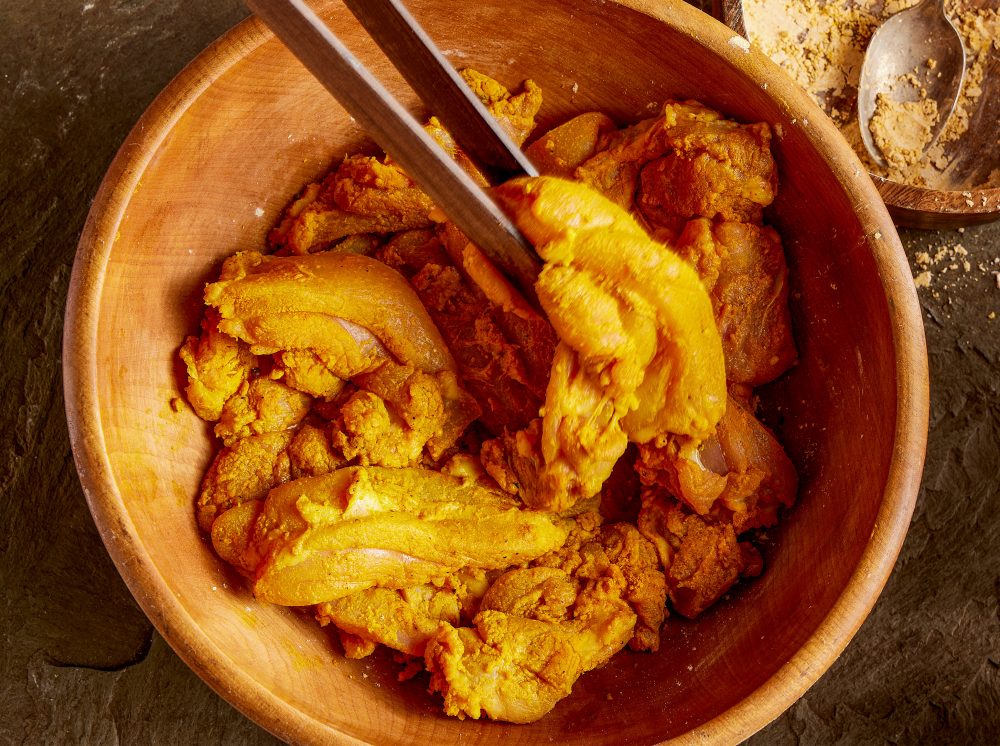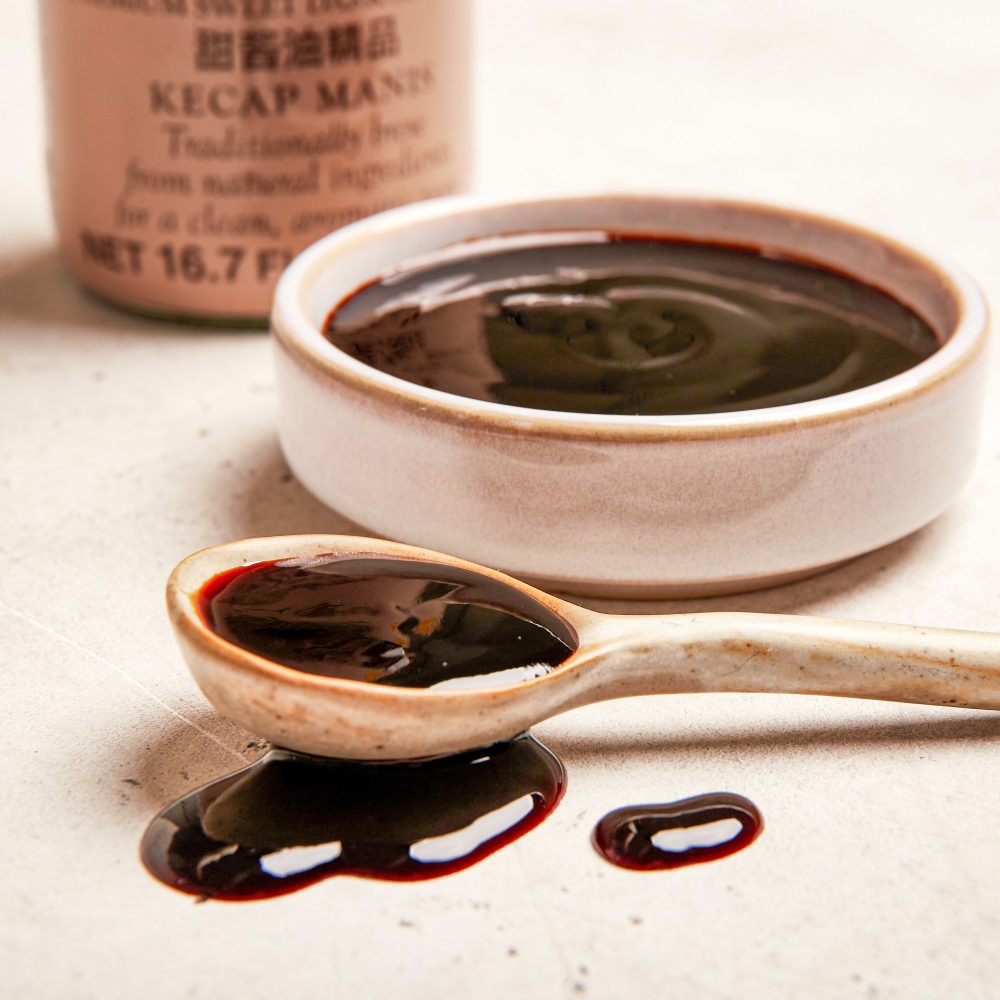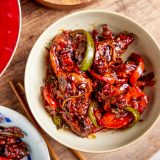Kuala Lumpur can feel a bit like Los Angeles, a car-centric urban sprawl, but with more skyscrapers and green pockets of tropical foliage. And like L.A., sometimes the best food is found not in upscale eateries, but hidden in that least likely of places: the mall.
It’s how I found myself at Cili Kampung at the Hartamas Shopping Center. To be honest, my expectations were low. But chef Bob Muze quickly set me straight, disabusing me of my misguided Western version of charm.
Nearly every dish was blisteringly spicy, but each was more delicious than the last. Smoked beef and potatoes bathed in coconut gravy. Sweet and spicy eggplant stir-fried with dried anchovies. Sea bass poached in a fiery broth.
The true surprise, though, was a dish so plainly named as to be easily overlooked: ayam masak kecap, or chicken cooked in soy sauce. But it was so much more: crispy deep-fried chicken coated in a sweet-savory glaze that was piquant rather than face-meltingly hot. The dish obviously contained soy sauce. But it also had a faint toasty bitterness and was fragrant in a way I couldn’t quite identify.
Neither could my guide. “The names of the dishes don’t come close to translating to what they actually are,” said Nicholas Ng, a local food writer. But he knew the chicken was coated with ground turmeric before it was deep-fried, then glazed with a sauce packed with aromatics. It was a version of a classic dish so simple, he and many others refer to it as bachelor’s chicken. Pardon the sexism, but by local lore it’s a dish so easy even a single man could make it.
Determined to find out more, I returned the following day for a lesson that turned out more hands-on than I anticipated.

When I ducked into the kitchen, Muze was slicing deep slashes in bone-in chicken parts, better for the flavors to seep into the meat, he explained. He rubbed them first with ground turmeric, then dropped the chicken into an enormous electric wok with sizzling oil—merely the first time the chicken gets cooked.
Then he revealed the keys to that powerful fragrance: shallot, ginger, garlic, turmeric and lemon grass. And he didn’t use just any soy sauce. It was kecap manis (sometimes spelled kicap), a powerhouse ingredient common to Malaysia and Indonesia made from soy sauce, water and palm sugar. The sugar is made by slowly boiling palm sap, imparting bitter-caramel smokiness—far more complex than one-note-sweet white sugar.
Once the chicken emerged from the oil, Muze cranked up the industrial burner to stir-fry the aromatics, the kitchen erupting with their scent as flames licked over the sides of the wok. He included only half of the shallots, enough to flavor the sauce, reserving the rest for later so they retain their texture.
“And now it’s campak, campak, campak,” said Muze. “Malaysian cooking is like that, you throw, throw, throw everything in fast.”
He tossed in ample white pepper—the main source of that piquant heat—with bell pepper and fresh chilies. After a few stirs, he again turned up the heat and poured the kecap manis down the sides of the wok, so the sauce instantly bubbled and reduced to a caramelized glaze.
The chicken was returned to the wok with tomatoes and the remaining shallots, plus a splash of water to loosen the reduced sauce. After frying the chicken, the dish finished in just three minutes.
Richly glazed and unbelievably fragrant, the chicken was crispy, yet luscious. The turmeric, lemon grass and aromatics melded with the bittersweet kecap manis, a combination so much more enticing than soy sauce and sugar.
Muze invited—maybe dared?—me to make my own version. As I bumbled through my first time with a professional wok, tossing in ingredients with my best campak, campak, he adjusted the flame like a doting parent. It came out tasty, but mine wasn’t nearly as good as Muze’s. That meant some work back at Milk Street.
Starting with the frying. To make less mess and speed the cooking, we skipped deep-frying bone-in parts in favor of shallow-frying strips of boneless chicken thighs. Looking for even more crispiness, we added ¼ cup of cornstarch to the turmeric coating, which also gave the sauce something to cling to.
Though kecap manis is increasingly available at supermarkets and online, it still can be hard to source. Mixing soy sauce with brown sugar and molasses approximated the bittersweet richness. And adding the tomato wedges with the cooked chicken released some of their liquid, replicating Muze’s splashes of water to rehydrate the sauce.
The result was crispy strips of chicken, tomatoes and peppers coated in a sauce just as aromatic as what I had in Kuala Lumpur. “I’ve learned so much from Western chefs,” Muze said. “But now I want to be the one to teach Malaysian cooking to the world.”

Kecap Manis: Malaysian Sweet Soy Sauce
Savory-sweet with bitter-caramel and faint smoky notes, kecap manis (sometimes spelled kicap) is the staple condiment of Malaysian and Indonesian kitchens. The best brands simmer naturally brewed soy sauce with palm sugar, which itself is a cooked-down sap that adds tons of bitter-toasted flavors.
We tasted five brands on their own and drizzled onto plain steamed white rice to determine which had the most natural flavor. Since true kecap manis can be difficult to find in the U.S., we also came up with a homemade version that adapts conventional soy sauce to approximate its flavor.
Our favorite brands were Megachef and ABC, which had complexity and layers of sweet, salty, umami and tart. Both also had great texture, thick enough to use as a sauce in their own right, but still smooth and liquid enough to be whisked into other ingredients. Conimex and Habhal’s were too thin and salty, tasting mostly of soy sauce; Bango was too thick and too sweet.
Surprisingly, we found our homemade version tasted nearly as good as our top-choice brands. To make a ¾-cup batch, whisk together ¼ cup each soy sauce, molasses and brown sugar. It can be refrigerated in an airtight container for several weeks.
The glaze-like texture of kecap manis can add deep flavor and body to a variety of meat and vegetable dishes. Brush it over grilled steaks, chops, chicken or salmon fillets to intensify the char-grilled flavor. Or, blend into a simple sauce to toss with meats before grilling or broiling: In a blender, combine 2 garlic cloves, 1 stalk lemon grass, ½ teaspoon black pepper, 2 to 3 tablespoons kecap manis, 1 tablespoon lime juice and 1 tablespoon fish sauce (optional). Toss with 1½ pounds pork, chicken or shrimp.
Kecap manis also can be drizzled over stir-fried or sautéed vegetables, such as green beans, sugar snap peas, asparagus or Broccolini, then finished with lime juice. Brush on roasted winter squash or sweet potatoes and finish with chopped cilantro, scallions and chili sauce. Also use instead of regular soy sauce to flavor fried rice or drizzle over omelets stuffed with garlicky sautéed greens.






